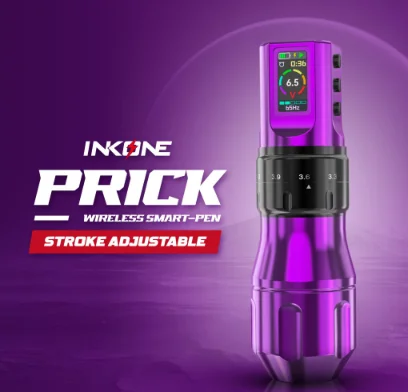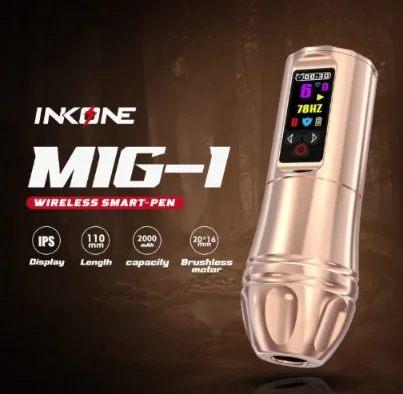
When it comes to tattooing, getting the right stroke setting isn’t just a small detail—it’s what separates a clean piece from a messy one. Even the most advanced tattoo wireless machine can’t save a tattoo if the stroke is set wrong. A stroke that’s too long can tear up skin; one that’s too short might leave your lines weak or patchy. It’s like trying to paint a wall with the wrong-sized brush—you’ll end up frustrated, and the results won’t last.
In studios everywhere, artists debate voltage, needle depth, and ink brands. But stroke length often flies under the radar, even though it defines how your machine actually behaves on skin. Understanding this single setting can mean the difference between an effortless session and a painful redo.
What Exactly Is Stroke in a Tattoo Machine?
In simple terms, the stroke is the distance your machine’s needle travels up and down in one cycle. Think of it as the length of your machine’s “breath.”
A longer stroke means the needle moves farther each time—it hits harder, penetrates deeper, and is perfect for bold lines or color packing. A shorter stroke is faster, softer, and better for smooth shading or delicate gradients.
But here’s the tricky part: stroke isn’t the same as needle depth. Many beginners confuse the two. Stroke affects how the machine moves; needle depth controls how deep the ink goes. They work together but play totally different roles.
How Stroke Settings Affect Your Work
Small changes in stroke can dramatically alter your results. A few tenths of a millimeter might make or break your linework.
Let’s look at how each range performs:
| Stroke Range | Typical Use | Key Benefits | Watch Out For |
|---|---|---|---|
| 1.8–2.5 mm | Soft shading, black & gray realism | Gentle on skin, smoother blends | Weak for large needle groups |
| 3.0–3.5 mm | Balanced, versatile for lining & shading | Great all-around setup | May need practice for fine details |
| 3.8–4.5 mm | Bold lining, color packing | Strong hit, deeper ink placement | Risk of overworking the skin |
For example, a 4.0 mm stroke might feel powerful for solid color fills, but if you use it for subtle shading, you could end up damaging skin. On the other hand, a 2.5 mm stroke feels quick and soft—but might not push enough pigment into tougher areas like shoulders or elbows.
If you’ve ever noticed a tattoo healing patchy even though your depth and voltage seemed right, chances are your stroke setting wasn’t.
The Science Behind a Smooth Hit
Tattoo machines aren’t just about looks or brand names. It’s physics and mechanics. A longer stroke means more travel distance, so the needle hits harder because of added momentum. It’s similar to how a hammer with a longer swing hits nails deeper.
Shorter strokes, meanwhile, have less travel time—making them quicker and ideal for layering shades. That’s why artists who specialize in realism or black & gray often choose compact strokes to build tones gradually.
It’s all about rhythm. Your hand speed, voltage, and stroke length must flow together. Once you get that perfect balance, the skin responds smoothly, ink settles evenly, and healing is faster.
What Happens When Stroke Goes Wrong
Let’s get real — most tattoo mishaps trace back to bad stroke decisions.
Here’s what can go wrong:
- Too long: The skin gets chewed up, leaving raised lines or scabs that don’t heal clean.
- Too short: Ink won’t hold well, and your lines will fade too soon.
- Uneven motion: Makes the needle “skip,” creating dots or shaky textures.
Wrong match for needle group: Large needle group with a short stroke means weak packing. A small group paired with a long stroke is just overkill and can be too aggressive on skin.
Stroke choice has a direct impact on healing. You might finish the session thinking the piece looks solid, color looks saturated, lines look strong — and then you see it healed two weeks later and it’s blown out, patchy, or scarred. That’s why artists sometimes call stroke setting the “silent saboteur.” You don’t always notice the damage while you’re still wiping during the session. You notice it when the client comes back.
Choosing the Right Stroke for Your Tattoo Wireless Machine
If you’re using a tattoo wireless machine, stroke matters even more. Wireless machines usually give you steadier power delivery and smoother drive, so the stroke the machine is built with often defines how it will hit the skin. In other words, you pick the machine with the stroke range that matches your job, instead of hoping the machine will “fix it for you.”
Here’s a simple guide many artists follow:
- Around 2.0–2.5 mm: Light shading, softer black and gray, thinner script.
- Around 3.0–3.5 mm: Versatile daily setup for lining, shading, and light packing.
- Around 3.8–4.5 mm: Bold lining, color packing, and high saturation work.
A wireless pen that’s built with a 4.0 mm stroke is generally aimed at strong lining and confident color packing, because that longer travel hits with more drive and puts pigment in faster. If you try to do ultra-soft micro lettering with that same long stroke, you may find it feels too punchy and can heal a little fuzzy. That is not the machine “being bad,” that’s just the stroke doing exactly what it’s designed to do.
Pro tip: Before you take any new setup to live skin, run it on fake skin or practice material so you can feel how it hits with your preferred voltage and needle group. Small differences in stroke length show up fast in healed work.

The Role of INKONE in Perfecting Stroke Control
At INKONE, precision isn’t treated like a bonus add-on. It’s the baseline the machines are built around. The InkOne NARW tattoo wireless machine is engineered to deliver a stable hit at its set stroke, with consistent power and smooth drive. Instead of chasing adjustment knobs, the focus is on repeatability: same feel, same penetration behavior, session after session.
What makes INKONE machines stand out is how they balance power and comfort. The motor delivers a steady drive even at low voltage, and its ergonomic grip minimizes vibration. So whether you’re doing a full back piece or small lettering, you stay in control—without the fatigue that older rotary machines used to cause.
And yes, for long sessions, you’ll notice the difference. The needle hits clean but doesn’t burn the skin. That’s the sweet spot every artist looks for.
Real-World Scenarios: Learning from Mistakes
Ever seen a tattoo that looks fine on day one but heals unevenly? That’s often stroke mismatch. One common case is using a long-stroke pen to do micro lettering. It looks bold on fresh skin, but once it heals, the edges look swollen or fuzzy.
Another common trap: switching from a softer, shorter-stroke pen to a wireless pen built around a longer stroke and a stronger motor, but keeping the exact same hand speed and voltage. The hit feels familiar in the moment, but the skin takes more trauma than expected and healing drags out.
The lesson is simple: your machine’s stroke, motor response, voltage, needle group, and your hand are all part of the same chain. Treat them like they belong together, not like they’re separate.
About Yiwu Yinke Electric Tools Co., Ltd.
Yiwu Yinke Electric Tools Co., Ltd. has been in the professional tattoo equipment field for years. They specialize in developing and producing high-quality tattoo wireless machines, tattoo pens, and accessories.
The company’s focus is on research, precision engineering, and artist feedback. Every INKONE machine undergoes strict inspection and performance tests before shipping. From the frame design to the motor tuning, everything aims to make tattooing more stable, comfortable, and accurate.
Their goal isn’t just to sell a machine—it’s to help artists perform better. That philosophy shows in every detail, from smooth voltage flow to how effortlessly the needle glides.
Conclusion
A wrong stroke setting can quietly destroy your tattoo long before you notice. It’s not dramatic—it’s subtle. Uneven color, shaky lines, irritated skin—all symptoms of a setting that didn’t match your intent.
But once you learn how stroke affects performance and choose a machine that gives you precise control, tattooing becomes smoother, faster, and less stressful. The right tattoo wireless machine—like those by INKONE—lets your skill truly shine.
Tattooing is an art, yes, but also a craft grounded in mechanics. When stroke, voltage, and hand motion align, every pass feels right, and your client’s skin heals clean. That’s when your work speaks for itself.
FAQs
Q1: What stroke setting is best for beginners using a tattoo wireless machine?
A: A medium stroke around 3.0–3.5 mm is usually the safest starting point. It’s versatile for lining and shading without hitting too hard, and it helps you build clean basics.
Q2: Can I change stroke settings during a tattoo session?
A: Some machines on the market have adjustable stroke cams or wheels. Others, like fixed-stroke wireless pens built around a set 4.0 mm hit, do not. Always know what your specific machine is built to do before you start working.
Q3: How do I know if my stroke is too long or too short?
A: If the skin raises, reddens fast, or looks chewed after just a couple of passes, the stroke is probably too long for that area or that needle group. If color looks faint or keeps wiping away, the stroke is probably too short for the job.
Q4: Why does stroke matter more in a tattoo wireless machine?
A: Wireless pens tend to give you consistent power delivery, so the stroke the pen is built around becomes a big part of how hard it actually hits. That fixed behavior is what gives you reliability, but it also means you need to choose the right stroke for the style you’re doing.
Q5: How often should I check my stroke setup?
A: Before every session. Even with a fixed-stroke pen, voltage changes, different needle group sizes, and different skin types can make the same stroke behave differently. A short test run lets you catch problems before the first permanent line.






